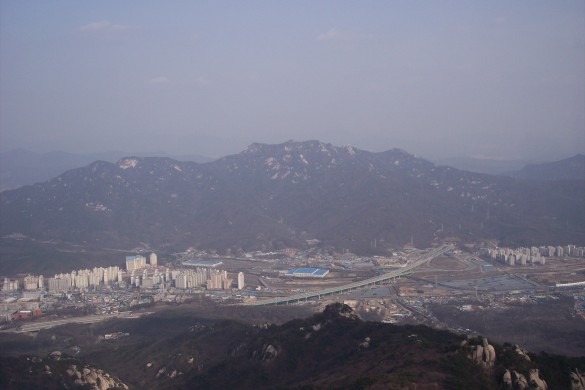Japan and South Korea share numerous things in common – among them: nameless streets, a tendency of co-workers to go out with each other after work for drinks, students studying ridiculous hours to prepare for university entrance exams, and cuisines typically unfriendly for vegetarians.
And another thing: excellent hiking opportunities near their capitals. While Tokyo offers Mount Fuji, those in Seoul can satisfy their hiking urges at Bukhansan National Park – home of Dobongsan. Unlike Mount Fuji, which can take at least an hour and a half to reach from the center of Tokyo, Bukhansan is easily accessible from downtown Seoul via lines one and seven on the Seoul Metropolitan Subway. After going through the gate at Dobongsan Station and making a right, only the street (in which bus stops are located in the middle) separate you from joining the crowd of hikers.
But before reaching the entrance of Bukhansan, a dirt road (then a paved road) takes you through a market. Numerous cafes and restaurants flank that path, but the most striking aspect of the short walk to the park entrance is the quantity of hiking equipment stores. After crossing the street exiting Dobongsan Station, one such store immediately greets you. Hiking boots, sticks, and other mountain suitable clothing is available. If you get off Dobongsan Station unprepared for hiking and you find one outdoor equipment store’s goods aren’t to you liking, don’t despair. Lafuma, Montbell, the North Face, and Millet (among others) are there to rip off… er, help those looking for better equipment.
As for the actual hike, after crossing the information office, two diverging paths emerge – the one going left heads to a mountain named Uiam. The one going straight leads to Dobongsan, the summit which is roughly three kilometers away. Despite arriving at Bukansan equipped with a Lonely Planet guide containing information about the place, I purposely don’t know too much about the park so I can learn about it through my own eyes during the hike. I’m thinking that reaching the summit shouldn’t be too difficult. I’m in shape, having completed the Tokyo Marathon 24 days prior. I’ve previously climbed Mount Fuji and Mount Gassan, Yamagata Prefecture’s highest mountain. This hike doesn’t worry me as Dobongsan doesn’t have an international reputation as being intimidating.
Sure enough, the hike is very simple at the beginning. The weather is so warm I’m lead to remove my sweatshirt and put it around my waist. Shortly after I pass a saxophonist, the smooth, paved path becomes slightly rocky, but no difficulties have arisen. At times, the path upwards curves like a snake but the way to the summit still seems pretty clear-cut. Unlike some touristy mountains, there are no distractions such as restaurants or shops. The other hikers I see making up their way up to Dobongsan all seem to be in their fifties or older. There are a group of school children near the Buddhist temple Gwangnyunsa but they’re likely on a school trip.

 Seoul from up top….
Seoul from up top….
But I push on – motivated by the fact the distance to the summit is dropping. Oddly enough at one point less than a half kilometer from the peak, I see trinkets of snow on this beautiful day weather-wise. After the ropes portion of the hike, the path doesn’t revert to being a straight incline but the rocks are laid out well enough that if you concentrate on your path, the summit will beckon.
Eventually, the sign says 0.3 km to Dobongsan. But within a few meters of that sign, an information board about Dobongsan (all in Korean) appears. I join the several nearby hikers relaxing and admiring the Seoul skyline. While we’re not looking down at the center of the city, we see a maze of highways encircling tan apartment buildings (that look much better from afar than from the inside of a nearby subway train) standing like dominoes. But that’s not the most impressive sight. While on the top of one mountain, your eyes behold more mountains overlooking a beaming city of more than ten million. It’s a perfect time to relax and gather your thoughts…
Before you ask yourself, “How the hell do I get back down?”